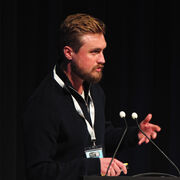Dr Nicholas Farr
School of Chemical, Materials and Biological Engineering
Research Fellow


Full contact details
School of Chemical, Materials and Biological Engineering
North Campus
Broad Lane
Sheffield
S3 7HQ
- Profile
-
After completing undergraduate studies in Human Biology at Loughborough University and Law at BPP Law School, Nicholas joined the Department of Materials Science and Engineering as a PhD researcher specialising in Tissue Engineering and Regenerative Medicine.
His early research focused on developing materials characterisation techniques tailored for the surface analysis of medical devices. Nicholas’s work demonstrated how advanced imaging approaches can elucidate the complex dynamics of cellular interactions with polymeric medical materials. Upon submission of his PhD thesis, he was awarded the EPSRC Prize Research Fellowship, enabling him to undertake independent research in medical device evaluation and instrumentation development.
Currently, Nicholas’s research centres on the innovation of analytical tools designed to improve existing pre-clinical testing methods for medical devices. With expertise in medical device characterisation and testing, he has authored numerous impactful studies, with recent work addressing key clinical challenges such as surgical mesh and breast implants. Working closely with Sheffield Teaching Hospitals, the MHRA, the NHS Implant Service, and partners in Germany and Australia, Nicholas’s research seeks to better understand implant degradation and its implications for patient outcomes.
In addition to his Fellowship, Nicholas has contributed to a range of materials characterisation projects funded by the EPSRC, UK Defence Science and Technology Laboratory (DSTL), UK Medical Research Council (MRC), and industrial collaborators including Johnson Matthey. His academic career has also been international, having served as a visiting researcher at the University of British Columbia (Canada), Technical University of Ostrava (Czech Republic), and Monash University (Australia).
- Research interests
-
Analysis of Explanted Medical Devices
Surgical mesh is one of several medical devices that Nicholas has characterised and published studies on. In 2021, he developed and published a study presenting a novel characterisation approach to reveal the mechano–chemical effects of oxidation and dynamic distension on polypropylene surgical mesh. This work was significant in demonstrating that polypropylene surgical mesh is susceptible to oxidative degradation and in elucidating how such degradation influences the functional performance. Following this study, Nicholas has published a series of complementary papers detailing the mechanisms of oxidative degradation in polypropylene surgical mesh. These include the first studies to characterise, quantify, and identify particles released from polypropylene mesh under oxidative stress; to analyse titanium-coated polypropylene surgical mesh explanted from patients; to culture macrophages (immune cells) directly onto surgical mesh; to mitigate surface cracking and crazing through plasma modification; and to demonstrate time-related degradation of polypropylene surgical mesh within the body.
He continues to advance research in this field in collaboration with internationally recognised clinicians and academics from institutions including NHS Teaching Hospital Trusts, the Institute for Pathology at Düren Hospital, University of Witten Herdecke, Leibniz Institute for Plasma Science and Technology, New York Structural Biology Centre, University of Queensland, University of Newcastle, Freeman Hospital, and University Hospitals KU Leuven.
Policy, Regulation, and Patient Safety
Nicholas’s interests extend beyond the laboratory, reflecting a commitment to ensuring that research outcomes contribute to policy development and public understanding. He has published several commentaries advocating for updates to existing legislation, including proposed amendments to the Consumer Protection Act, to better address the complexities of modern medical devices and patient safety.
He has also engaged directly with government departments and contributed written evidence to parliamentary inquiries. Most recently to the Women’s Health and Equality Committee investigation into breast implant safety and cosmetic regulation. His contributions have informed ongoing discussions on regulatory frameworks governing medical implants and post-market surveillance.
Driven by a commitment to patient engagement, Nicholas collaborates closely with patient groups and charities, facilitating open discussions on medical device safety and performance. These conversations provide valuable insights that not only guide his research but also help shape more patient-centred regulatory and scientific approaches.
- Publications
-
Journal articles
- “Absence of evidence is not evidence of absence”—rethinking NHS England`s inguinal hernia surgery decision aid. Hernia, 29(1). View this article in WRRO


- Towards automated chemical analysis of materials using secondary electron hyperspectral imaging and unsupervised learning. IEEE Access, 13, 173976-174000. View this article in WRRO


- Advancing synthetic bone tissue engineering materials: Nano-scale investigation into transitional Interface in carbon dots/ polymer composites. Journal of Colloid and Interface Science, 700(Part 3). View this article in WRRO


- Secondary electron hyperspectral imaging of carbons: new insights and good practice guide. Advanced Science. View this article in WRRO


- Effects of degradation-associated polypropylene particles in the surrounding tissue after surgical mesh implantation. Nature Reviews Urology. View this article in WRRO


- Capturing microalgae within aerosols provides carbon capture bio-functionality. Journal of CO2 Utilization, 92. View this article in WRRO


- 25 Novel biomaterials for stress urinary incontinence: development of a clinically relevant large animal model to mimic suburethral implantation. European Urology Open Science, 71, S28-S29.


- Evidence of time dependent degradation of polypropylene surgical mesh explanted from the abdomen and vagina of sheep.. Journal of the Mechanical Behavior of Biomedical Materials, 160. View this article in WRRO


- Strengthening preclinical testing to increase safety in surgical mesh. Nature Reviews Urology, 21, 515-516. View this article in WRRO


- Uncovering the relationship between macrophages and polypropylene surgical mesh. Biomaterials Advances, 159. View this article in WRRO


- Carbon nanotubes facilitate silk hierarchical assembly by dry drawing. Small Structures, 5(4). View this article in WRRO


- Revealing the morphology of ink and aerosol jet printed palladium-silver alloys fabricated from metal organic decomposition inks. Advanced Science, 11(10). View this article in WRRO


- Regulating the formation and extent of crazing through the application of argon plasma surface functionalisation. Polymer Testing, 128. View this article in WRRO


- Highly efficient carbon dot-based photoinitiating systems for 3D-VAT printing. POLYMER CHEMISTRY, 2023(38), 4375-4496.


- Insights into surface chemistry down to nanoscale: an accessible colour hyperspectral imaging approach for scanning electron microscopy. Materials Today Advances, 19. View this article in WRRO


- Assessing the quality of oxygen plasma focused ion beam (O-PFIB) etching on polypropylene surfaces using secondary electron hyperspectral imaging. Polymers, 15(15). View this article in WRRO


- Development of PCL polyHIPE substrates for 3D breast cancer cell culture. Bioengineering, 10(5).


- Characterization and quantification of oxidative stress induced particle debris from polypropylene surgical mesh. Nano Select.


- Characterization in respect to degradation of titanium‐coated polypropylene surgical mesh explanted from humans. Journal of Biomedical Materials Research Part B: Applied Biomaterials.


- Revealing localised mechanochemistry of biomaterials using in situ multiscale chemical analysis. Materials, 15(10). View this article in WRRO


- Low-voltage SEM of air-sensitive powders: from sample preparation to micro/nano analysis with secondary electron hyperspectral imaging. Micron, 156. View this article in WRRO


- A novel characterisation approach to reveal the mechano–chemical effects of oxidation and dynamic distension on polypropylene surgical mesh. RSC Advances, 11(55), 34710-34723. View this article in WRRO


- Monitoring carbon in electron and ion beam deposition within FIB-SEM. Materials, 14(11). View this article in WRRO


- Identifying and mapping chemical bonding within phenolic resin using Secondary Electron Hyperspectral Imaging. Polymer Chemistry, 12(2), 177-182. View this article in WRRO


- Understanding surface modifications induced via argon plasma treatment through secondary electron hyperspectral imaging. Advanced Science, 8(4). View this article in WRRO


- Characterizing cross‐linking within polymeric biomaterials in the SEM by secondary electron hyperspectral imaging. Macromolecular Rapid Communications, 41(3). View this article in WRRO


- Optimizing size and distribution of voids in phenolic resins through the choice of catalyst types. Journal of Applied Polymer Science, 136(47). View this article in WRRO


- UK Consumer Protection and the Debate for Reform in Medical Device Liability. Laws, 15(1), 1-1.


Conference proceedings
- Unsupervised learning assisted secondary electron hyperspectral imaging for high-throughput cheminformatics analysis of materials. BIO Web of Conferences, Vol. 129. Copenhagen, Denmark, 25 August 2024 - 25 August 2024. View this article in WRRO


- A secondary electron hyperspectral imaging characterisation of mechanochemically functionalised carbon black materials. BIO Web of Conferences, Vol. 129. Copenhagen, Denmark, 25 August 2024 - 25 August 2024. View this article in WRRO


- Application of secondary electron hyperspectral imaging to the analysis of pharmaceutical materials. BIO Web of Conferences, Vol. 129. Copenhagen, Denmark, 25 August 2024 - 25 August 2024. View this article in WRRO


- Secondary Electron Hyper Spectral surface imaging for beam sensitive biomaterial characterisation. Proceedings of the Microscience Microscopy Congress 2021 incorporating EMAG 2021


- Secondary Electron Hyper Spectral surface imaging for beam sensitive biomaterial characterisation. Proceedings of the European Microscopy Congress 2020


- “Absence of evidence is not evidence of absence”—rethinking NHS England`s inguinal hernia surgery decision aid. Hernia, 29(1). View this article in WRRO
- Media
Nicholas is actively involved in disseminating his research to the public. He has authored numerous public-facing articles and has contributed to platforms such as Sky News Radio. Nicholas regularly engages with the general public and patient groups interested in his research, resulting in Q&A articles that provide valuable insights. Additionally, Nicholas has contributed to documentaries, sharing his passion for science and engineering. He collaborated on the BBC 4 Documentary series "The Secrets of Size: Going Small" and a series called “Engineering Reborn” premiering on Channel 4 - also available on BBC Earth (worldwide) and SDS (Australia).
- Vaginal mesh material degrades within 60 days
- Material commonly used in vaginal mesh implants starts to degrade within 60 days of being implanted in the pelvis
- UK Scientists Develop New Testing Method for Biomaterials
- Repeat of vaginal mesh scandal could be prevented by new early warning system
- Medical device safety: effective testing is key
- New Testing Method Easily Identifies Clinically Incompatible Biomaterials
- Biomaterials test could prevent medical trauma
- New test regime for biomaterial safety
- The impact of implanting plastic surgical mesh: Q&A with researcher Nicholas TH Farr
